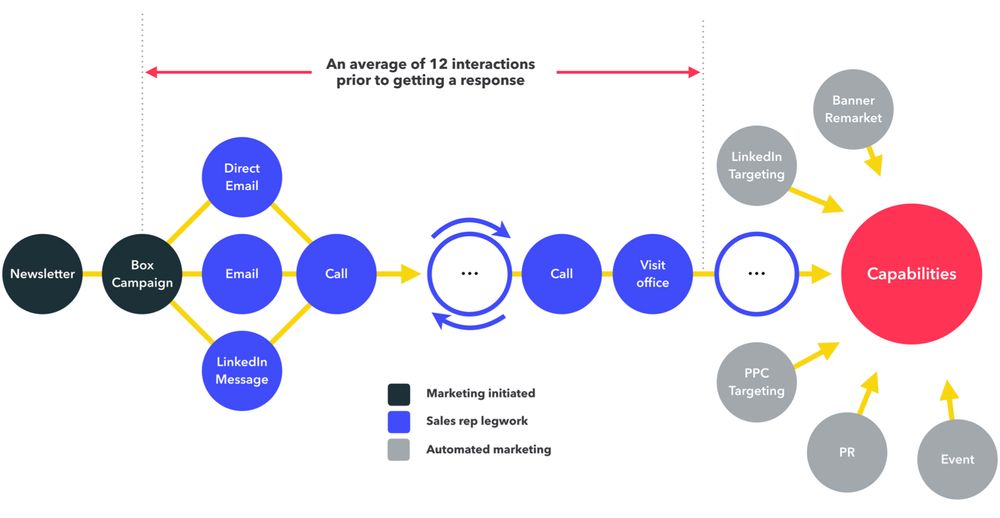Make multiple touchpoints
A successful marketing strategy relies on a combination of both carpet bombing and sniping. Industry research indicates that a cold prospect needs at least twelve touchpoints to respond to an inquiry, assuming there’s interest and a match in demand. Owing to the nature of our business, we’re not really looking to create demand (unlike classic B2C marketing for retail goods). We know demand exists, so we need to be relevant and timely with our touchpoints.
Below you can find a good example of how multiple touchpoints drive toward a capabilities presentation with the prospect. Some of the actions are active like calls and emails, whereas others are passive, such as advertising through LinkedIn.

Investing time to engage leads
An interesting metric to monitor as we invest in marketing efforts is the cost per lead or even cost per opportunity. If we were selling pizza, our cost per lead would need to be really low—there’s a lower margin on a twenty-dollar pizza (Chicago-style, of course). But we’re in the business of enterprise products with costs in the millions, often tens of millions over multiple years. Is $1,500 a reasonable amount for a chance to partner with a major airline? How about $50,000? It depends.
We have erred in the past and have gotten excited over a new potential account only to discover the individual talking to us was not in a buying position. Raising the troops and investing into a prototype may be premature. We’ve also made the opposite mistake. We’ve spent millions of dollars on our marketing engine only to underprepare for an initial capabilities session with a Fortune 1000 account . . .
We have found great success from investing our time into no-cost prototypes, research, and product explorations as a means to win an audience and ultimately an opportunity. We don’t enter into these early-stage engagements lightly, but as long as we have access to the sponsor and an identified need, and the account matches our strategic account qualification, we’re down! To research, design, and prototype, these products may require a couple of weeks of work from a small team of PMs and product designers.
Each strategic client may spend millions during the account lifetime. Err on the side of overinvesting to close the deal.
Remarketing
In addition to direct marketing, we invest in remarketing content. Raising awareness inside an existing account is called “remarketing.” We use a variety of account-based marketing tactics to craft focused messaging for existing clients. We create content and messaging that is intended to be circulated around the client’s enterprise. We regularly implement marketing best practices for existing account expansion. Because we have a master service agreement (MSA) and our foot is in the door, this is a much easier and shorter road to new revenue to expand an existing account. We push our managing directors to focus on existing account expansion first and foremost because their investment of time will typically yield much higher returns as compared to cold outbound pursuits. Here are a few examples of remarketing campaigns that have been effective for us
- Feature release training video. The Devbridge team films and promotes a set of new features for the product. The video is shared with the client and distributed throughout the enterprise. This accomplishes several objectives: it shows the faces behind the work being done (our team), demonstrates improvement to the client’s software, and elevates the perception of the product.
- Product video case study. We film a case study with the client, focusing on the successes of our stakeholders and project participants. The video is all about the client, with very little mention of Devbridge. While seemingly a self-promotion vehicle for our buyer, it is branded with our name and then gets organically promoted throughout the enterprise. Delivering results and allowing our clients to celebrate those results is extremely effective in generating new sources of revenue from the account.
- Product documentation and process improvements. We create a keynote deck with a high-level overview of the product strategy, successes, and failures. Furthermore, we document areas where we can help clients improve their own processes—delivery, security, onboarding, CI/CD, DevOps, and the like. This is also a great example of taking ownership—even after we deliver the product, we’re still working on advancing our client’s organization.
- Future product vision and prototypes. We not only deliver what is required but also invest time and effort into designing future states of the product. This may mean selecting the highest value features that didn’t make it into this iteration and demonstrating what the future product could become. This requires an insignificant effort from our team but shows immense goodwill and ownership to the client. The probability of a V2 build just increased.
Remarketing is effective because we are working to make our stakeholders and clients more successful. From celebrating the work they have done to helping them paint an improved future state, we give our sponsors the tools to advance their organization’s agenda as well as their careers. Never forget that behind every business decision is an individual with unique motivations.